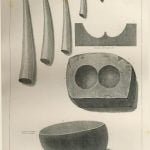
This instrument was used by the aborigines of this continent, for crushing the zea maize, and for reducing quartz, feldspar, or shells, to a state, which permitted it to be mixed with the clays of which their pottery was made. The first use is best exemplified by the excavated block of stone, formerly and still employed by the Aztecs, for making tortillas.
Of the mortar for pounding stones to temper their pottery, a specimen is herewith figured, (Figs. 6 and 7, Plate 27.) This ancient implement, which is double-chambered, was discovered by the writer in the Seneca country, in the vicinity of Buffalo City the ancient De-o-se-o-wa of the aborigines. It consists of a heavy and angular block of the cornutiferous limestone of Western New York.
Fig. 8, Plate 27, is a corn-cracker of the Paquea Indians. It is of very hard stone, and was found on the Potomac. This specimen is in possession of the National Institute, at Washington, D. C.
